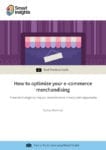"Work smarter, not harder" - that’s always been my mantra (but ironically, only said after I end up doing a helluva lot of hard work!)
When it comes to e-commerce merchandising, we now have the technology and tactics we could have only dreamed of only five years ago. With the advent of richer analytics and artificial intelligence (AI), we can now personalize user experiences in real-time. As a result, your prospects feel more understood than ever before, which makes them more likely to become paying customers.
How can I optimize? Let me count the ways
The most common optimization methods used as of early 2018 include:
- Using smart product recommendations
- Adding up-sells and cross-sells to your offers
- Offering intent-based collections
- Tailoring the user experience by customer segment
- Tailoring the user experience with real-time analytics
Using smart product recommendations
Amazon.com has set the standard for product recommendations. Their website seems to ‘read your mind’ and know what you want before you even know. The secret to this clairvoyance is their proprietary recommendation engine. It certainly helps that their algorithm is tuned by millions of clicks and purchases from their loyal customers.
The stats are compelling:
- An Accenture report says that personalization increases the likelihood of a prospect purchasing from you by 75 percent
- According to a McKinsey study, 35 percent of sales on Amazon.com and 75 percent of Netflix sales were directly related to product recommendations.
Most importantly, providing personalized recommendations makes your brand look more professional like you are a premier solution provider. This reflects well both on your brand and your bottom line.
Adding up-sells and cross-sells to your offers
As an online merchandiser, you should always seek to do solution selling - that is, to provide a complete solution to the prospect’s problem. This involves offering both up-market alternatives (up-sells) when your prospect is still shopping, and related accessories (cross-sells) after your prospect has carted a product.
Up-sells are a hard sell because they depend on your prospect’s price sensitivity (for example, a Toyota buyer usually won’t consider a Lexus). Cross-sells, priced at 15% or less of the carted product, tend to convert much better. Best of all, cross-sells can significantly boost your average order value (AOV), even if a small percentage of your customers opt to add them.
Offering intent-based collections
Offering product collections is an effective tactic for driving engagement for prospects who are looking for a product that fits a ‘theme’ - such as what’s trending, what’s right for the season, or outfits that fit a particular ‘look’ or ‘style’.
By offering collections, through your top-level navigation and main landing pages, you’re allowing your visitors to short-cut your conventional category and product-based navigation. They will appreciate how you respect their time by giving you more product views and add-to-carts.
You should determine what these intents are based on your customer research. For example, you could run a simple online poll on your home and entry pages that asks, ‘What are you looking to find today?’ After you get a few hundred responses, you’ll have a good sense of the intents around which to create your collections.
Tailoring your user experience by customer segment
If you’ve been doing online selling long you know that it’s much easier to keep - and monetize - a current customer than to acquire a new one. So you need to give these returning visitors and customers special attention.
You can do this by:
- Promoting items added to their wish list: For example, you can simply push these items to entry pages so they are noticed again.
- Making reordering items super easy: Amazon does a good job of this in their ‘Orders’ section. There’s no need to reinvent the wheel if their approach is proven.
- Offering loyalty discounts or programs: Offer your repeat customers a discount or ‘freebie’ just for being loyal. A little appreciation can go a long way.
How do you know which customers are most profitable? Feed your customers list into a segmentation tool like those offered by Nielsen-Claritas or Experian. These tools output the psychographic profiles in which your customers ‘cluster’ and show which segments are most profitable. This allows you to target more like-minded people in your sales and marketing efforts.
Tailoring your user experience with real-time analytics
I’ve already touched on the conversion power of personalized product recommendations. Well, that’s just scratching the surface. With the latest dynamic personalization tools, you can customize the experience of each visitor in real time. These personalizations are even better if they are ‘seeded’ with other experiential data - from prior sessions, for example, or with data in your Customer Relationship Management (CRM) system.
Just as importantly, these tools allow you to run reports that cross-tabulate things like AOV and RPV against visitor behaviours like chat usage or video views. So you can quickly learn which behaviours and usage times correlate with higher conversion rates and revenues. I call this conversion gold!
Start selling smarter now
With the advent of cool new technologies, selling a lot more with a modest investment has never been easier. Read our guide full of optimization tips to ensure you never let a sale slip away.







